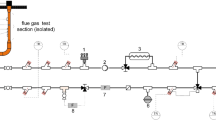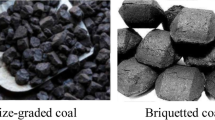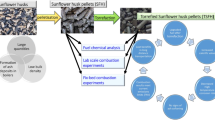Abstract
The introduction of wood chips into the market for small-scale heating appliances of below 100 kW has become more challenging due to stricter regulations on emission levels for carbon monoxide and particle emission, e.g. in Germany. Therefore, it is important to identify high wood chip qualities that are suitable for failure-free and low-emission combustion. In this investigation, several wood chip assortments produced from stem wood and forest residues were analysed and combusted in up to two different wood chip boilers with a nominal heat capacity of 50 and 99 kW at full load. Some combustion tests were performed at part load (i.e. 30% heat output). Throughout experiments, the emission behaviour was measured (CO, NOX and total particulate matter (TPM)). In total, seven different wood chip assortments were tested in the large boiler, whereas ten wood chip assortments were combusted in the smaller furnace. Wood chips from stem wood are characterized by lower ash contents (0.27–1.05 w%, d.b.), lower nitrogen contents (0.04–0.14 w%, d.b.) and lower aerosol forming elements (379–1075 mg/kg, d.b.) compared to forest residues (A = 0.58–2.05 w%¸ N = 0.13–0.32 w%, aerosols = 728–2199 mg/kg, d.b.). Combustion of stem wood caused lower emissions compared to forest residues at full-load operation. Overall, part-load operation caused higher CO and particle emissions. In addition, increases of fine woody particles lead to increases in CO emissions. The influence of moisture content was more pronounced especially for CO emissions.





Similar content being viewed by others
Abbreviations
- A:
-
Ash content
- a.r.:
-
As received
- BD:
-
Bulk density
- CO:
-
Carbon monoxide
- d.b.:
-
Dry basis
- DIN:
-
Deutsches Institut für Normung (German Institute for Standardization)
- EN:
-
European standard
- FTIR:
-
Fourier transform infrared spectroscopy
- MC:
-
Moisture content
- NOX :
-
Nitrogen oxides
- PM1:
-
Particles ≤1 μm
- Q:
-
Net calorific value
- STP:
-
Standard temperature and pressure
- TPM:
-
Total particulate matter
- VDI:
-
Verein Deutscher Ingenieure (The Association of German Engineers)
- WC:
-
Wood chips
References
Wilnhammer M, Wittkiopf S, Richter K, Weber-Blaschke G (2017) The impact of a new emission control act on particulate matter emissions from residential wood energy use in Bavaria, Germany. J Clean Prod 145:134–141
Bundesrepublik Deutschland (2010) Erste Verordnung zur Durchführung des Bundes-Immisionsschutzgesetztes (Verordnung über kleine und mittlere Feuerungsanlagen -1. BImSchV). Deutscher Bundestag, Drucksache 17/74, vom 25.11.2009, In force: 22.03.2010
Kaltschmitt M, Hartmann H, Hofbauer H (2016) Energie aus Biomasse–Grundlagen, Techniken, Verfahren. Springer, ISBN 978-3-662-47438-9
Rackl M, Günthner WA (2016) Experimental investigation on the influence of different grades of wood chips on screw feeding performances. Biomass & Bioenergy 88:106–115
Hinterreiter H, Hartmann H, Turowski P (2012) Method for determining bridging properties of biomass fuels—experimental and model approach. Biomass Conversion and Biorefinery 2(2):109–121
Morán JC, Miguez JL, Porteiro J, Patino D, Granada E (2015) Low-quality fuels for small-scale combustion boiler: an experimental study. Energy Fuel 29:3064–3081
Sommersacher P, Brunner T, Obernberger I (2012) Fuel indexes: a novel method for the evaluation of relevant combustion properties of new biomass fuels. Energy Fuel 26(1):380–390
Brunner T, Sommersacher P, Obernberger I (2011) Fuel index—a novel method for the evaluation of relevant combustion properties of new biomass fuels. In: ETA renewable energies (ed) Proceedings 19th European Biomass Conference and Exhibition–From Research to Industry and Markets, Berlin, Germany, 06–10 June 2011. Florence, Italy, pp 1351–1357
Obernberger I, Brunner T (2015) Advanced characterization methods for solid biomass fuels. Report of the IEA Bioenergy Task 32 project, Graz
Stubenberger G, Scharler R, Zahirovic S, Obernberger I (2008) Experimental investigation of nitrogen species release from different solid biomass fuels as a basis for release models. Fuel 87:793–806
Glarborg P, Jensen AD, Johnsson JE (2003) Fuel nitrogen conversion in solid fuel fired systems. Prog Energy Combust Sci 29:89–113
Liu H, Chaney J, Li J, Sun C (2013) Control of NOX emissions of a domestic/small-scale biomass pellet boiler by air staging. Fuel 103:792–798
Lamberg H, Tissari J, Jokiniemi J, Sippula O (2013) Fine particle and gaseous emissions from a small-scale boiler fueled by pellets of various raw materials. Energy Fuel 27:7044–7053
Obernberger I, Brunner T, Bärnthaler G (2007) Fine particulate emissions from modern Austrian small-scale biomass combustion plants. 15th European Biomass Conference & Exhibition, Berlin, Germany, pp 1546–1557
Schmidl C, Luisser M, Padouvas E, Lasselberger L, Rzaca M, Ramirez-Santa Cruz C, Handler M, Peng G, Bauer H, Puxbaum H (2011) Particulate and gaseous emissions from manually and automatically fired small scale combustion systems. Atmos Environ 45:7443–7454
Leskinen J, Tissari J, Uski O, Viren A, Torvela T, Kaivosoja T, Lamberg H, Nuutinen I, Kettunen T, Joutsensaari J, Jalava PI, Sippula O, Hirvonen M-R, Jokiniemi J (2014) Fine particle emissions in three different combustion conditions of a wood chip-fired appliance—particulate physico-chemical properties and induced cell death. Atmospheric Environment 86:129–139
Baumgartner T, Lermer A, Schön C, Kuptz D, Hartmann H (2015) Brennstoffqualität von Holzpellets–Europaweites Holzpelletscreening mit Fokus auf den deutschen Markt. Berichte aus dem TFZ, Nr. 43. Straubing. ISSN 1614–1008
Kuptz D, Dietz E, Blum U, Schulmeyer F, Hartmann H, Borchert H (2016) Qualität von Holzhackschnitzeln in Bayern–Gehalte ausgewählter Elemente, Heizwert und Aschegehalt. Berichte aus dem TFZ, Nr. 46. Straubing. ISSN 1614–1008
AshMelT (2015) Development of a practical and reliable ash melting test for biomass fuels, in particular for wood pellets. Final report, 2015 (yet unpublished)
Buchmayr M, Gruber J, Hargassner M, Hochenauer C (2015) Experimental investigation of the primary combustion zone during staged combustion of wood-chips in a commercial small-scale boiler. Biomass & Bioenergy 81:356–363
DIN EN ISO 18134-2 (2015) Solid biofuels—determination of moisture content—oven dry method—part 2: total moisture—simplified method. Berlin: Beuth 2015
DIN EN ISO 17828 (2015) Solid biofuels—determination of bulk density. Berlin: Beuth 2015
DIN EN 14778 (2011) Solid biofuels—sampling. Berlin: Beuth 2011
DIN EN 14780 (2011) Solid biofuels—sample preparation. Berlin: Beuth 2011
DIN EN ISO 17827-1 (2016) Solid biofuels—determination of particle size distribution for uncompressed fuels—part 1: oscillating screen method using sieves with apertures of 3,15 mm and above. Berlin: Beuth 2016
DIN EN 14918 (2011) Solid biofuels—determination of calorific value. Berlin: Beuth 2011
DIN EN ISO 18122 (2016) Solid biofuels—determination of ash content. Berlin: Beuth 2016
DIN EN 15104 (2011) Solid biofuels—determination of total content of carbon, hydrogen and nitrogen. Berlin: Beuth 2011
DIN EN 152889 (2011) Solid biofuels—determination of total content of sulfur and chlorine. Berlin: Beuth 2011
DIN EN ISO 16967 (2016) Solid biofuels—determination of major elements—Al, Ca, Fe, Mg, P, K, Si, Na and Ti. Berlin: Beuth 2016
DIN EN ISO 16968 (2016) Solid biofuels—determination of minor elements. Berlin: Beuth 2016
Deutsches Institut für Normung e.V. (DIN) (2014) DIN EN ISO 17225-4. Solid biofuels—fuel specifications and classes—part 4: graded wood chips. Berlin: Beuth
Deutsches Institut für Normung e.V. (DIN) (2014) DIN EN ISO 17225–2. Solid biofuels–fuel specifications and classes—part 2: wood pellets. Berlin: Beuth
DIN EN 303-5 (2012) Heating boilers—part 5: heating boilers for solid fuels, manually and automatically stoked, nominal heat output of up to 500 kW—terminology, requirements, testing and marking. Berlin: Beuth 2012
VDI 2066, Part 1 (2016) Particulate matter measurement, Dust measurement in flowing gases – Gravimetric determination of dust load. Beuth, Berlin 2006
Kuptz D, Hartmann H (2015) The effect of raw material and machine setting on chipping performance and fuel quality—a German case study. Int J For Eng 26(1):60–70
Kuptz D, Mack R, Rist E, Schön C, Hartmann H (2016) Wirkung der Aufbereitungskesse auf das Verbrennungsverhalten in Holzhackschnitzelfeuerungen. 14. Holzenergie-Symposium–Verwendungsoptionen und neue Entwicklungen. 16. September 2016 in Zurich, Switzerland
Serrano C, Portero H, Monedero E (2013) Pine chips combustion in a 50 kW domestic biomass boiler. Fuel 111:564–573
Zeng T, Weller N, Pollex A, Lenz V (2016) Blended biomass pellets as fuel for small scale combustion appliances: influence on gaseous and total particulate matter emissions and applicability of fuel indices. Fuel 184:689–700
Acknowledgments
This research was funded by Federal Ministry of Agriculture by decision of the German Bundestag with the Fachagentur Nachwachsende Rohstoffe e. V. (FNR) as project executing organization within the projects OptiChip and HackZert. We thank our colleagues Elisabeth Rist, Albert Maierhofer, Benedikt Haas, Stephan Winter and Anja Rocktäschel for their support during these studies.
Author information
Authors and Affiliations
Corresponding author
Rights and permissions
About this article
Cite this article
Schön, C., Kuptz, D., Mack, R. et al. Influence of wood chip quality on emission behaviour in small-scale wood chip boilers. Biomass Conv. Bioref. 9, 71–82 (2019). https://doi.org/10.1007/s13399-017-0249-7
Received:
Revised:
Accepted:
Published:
Issue Date:
DOI: https://doi.org/10.1007/s13399-017-0249-7




